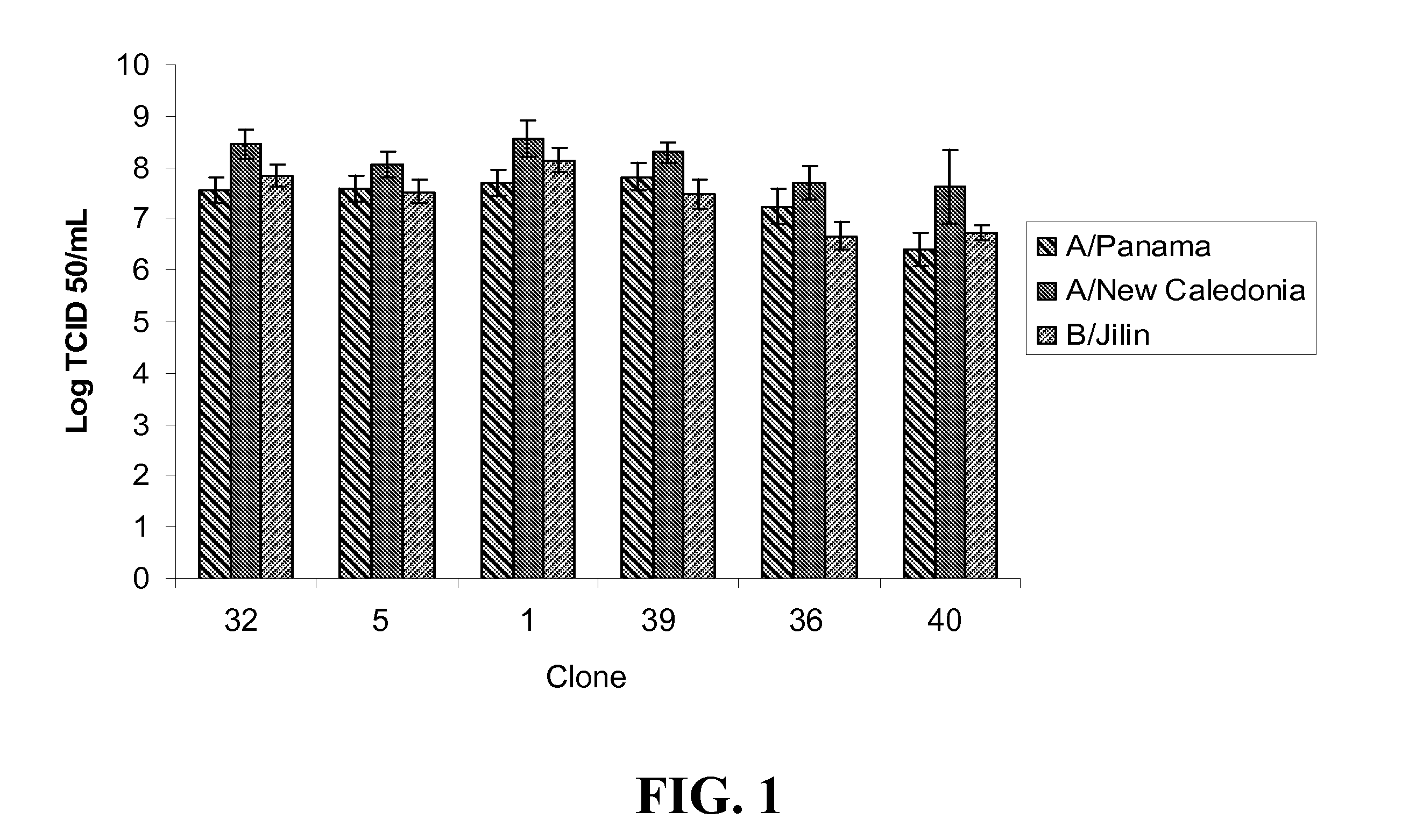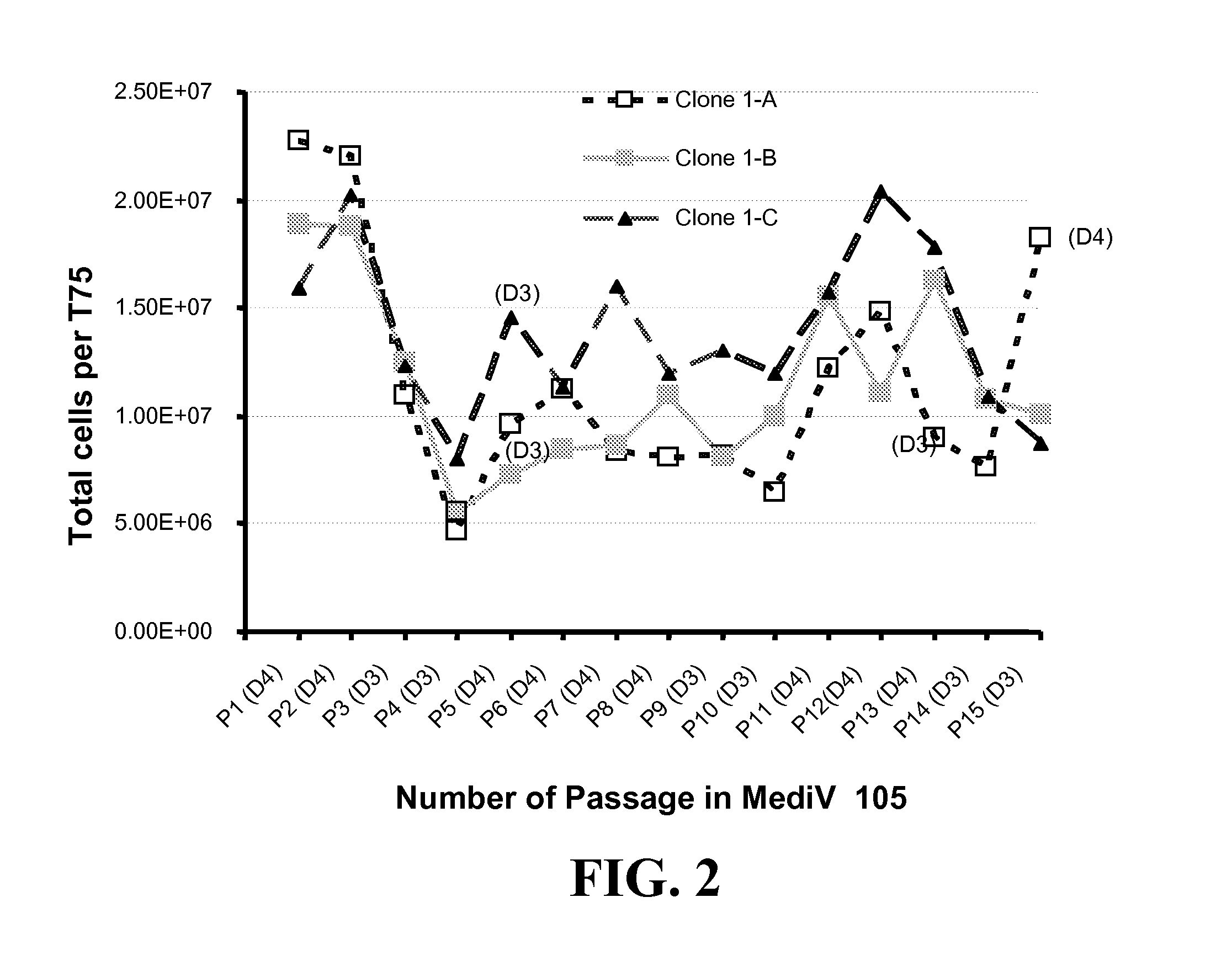Mdck cells lines supporting viral growth to high titers and bioreactor process using the same
a technology of mdck cells and high titers, applied in the field of mdck cells, can solve the problems of long lead time required to produce vaccines, problems such as problems in addressing outbreaks of disease, and existing mdck cell lines suffer from several defects
- Summary
- Abstract
- Description
- Claims
- Application Information
AI Technical Summary
Benefits of technology
Problems solved by technology
Method used
Image
Examples
specific embodiments
[0133]1. A Madin-Darby Canine Kidney (MCDK) cell, wherein a cell culture composition comprising a plurality of the MDCK cells supports replication of an attenuated, cold-adapted, temperature sensitive influenza virus to a base 10 logarithm of the median tissue culture infection dose per milliliter (log10 TCID50 / mL) of at least about 7.0 or to a base 10 logarithm of fluorescent focus units per milliliter (log10 FFU / mL) of at least about 7.0.
[0134]2. The MDCK cell of embodiment 1, wherein the MDCK cells support replication of the influenza virus to a log10 TCID50 / mL of at least about 7.2 and / or to a log10 FFU / mL of at least about 7.2.
[0135]3. The MDCK cell of embodiment 1, wherein the MDCK cells support replication of the influenza virus to a log10 TCID50 / mL of at least about 7.4 and / or to a log10 FFU / mL of at least about 7.4.
[0136]4. The MDCK cell of embodiment 1, wherein the MDCK cells support replication of the influenza virus to a log10 TCID50 / mL of at least about 7.6 and / or to a ...
example 1
Identification of a MDCK Cell Line that Supports High Viral Replication in Serum Containing Media
[0263]This example describes identification and selection of an MDCK cell line that supports replication of influenza viruses to high titers when the MDCK cell line was cultured in Dulbecco's Modified Eagle's Medium (DMEM) media comprising 10% Fetal Bovine Serum (FBS). The process is outlined in FIG. 5A.
[0264]One vial of MDCK cells (ATCC Accession No. CCL-34; Lot 1805449; passage 54) obtained from the ATCC was thawed and inoculated into a T-25 flask (Corning) containing 10 ml of Dulbecco's Modified Eagle's Medium with L-glutamine (DMEM) and 10% fetal bovine serum (FBS, Defined). Cells (passage 55) were incubated at 37±1° C. with 5±1% CO2 for 3 days. On day 3, the cells were passaged to a T-225 flask (passage 56). Three days after seeding, cells were passaged to 4×T-225 flasks (Passage 57). For each of the passages in DMEM with L-glutamine and 10% FBS in a T-25 or T-225 flask, the procedu...
example 2
Adaptation of an MDCK Cell Clones to Growth in Serum-Free Media
[0279]This example describes adaptation of MDCK Clones 1, 55, 56, 57, and 58 and Subclones 1-A, 1-B (P5 / P85), 1-C and 1-D to growth in MediV 105 serum-free media. Clones 56, 57, and 58 were derived from MDCK cells (ATCC Accession No. CCL-34) and adapted to growth in media containing serum in a manner similar to that described in Example 1. The process is outlined in FIG. 5B.
[0280]First, one vial of the MDCK Clone Subclone 1-D (frozen at passage 5 since subclone, P85 in total) was thawed and inoculated into a T75 flask containing 35 ml of Dulbecco's Modified Eagle's Medium / Ham F12 (DMEM / F12) with L-glutamine and 10% fetal bovine serum (FBS, Defined), and incubated at 37° C. with 5% CO2 for 3 days. On day 3 the cells were passaged to a T225 flask (Passage 7 / P87). Next, the MDCK Subclone D cells were adapted in serum-free medium MediV 105 for 5 passages.
[0281]At passage 5 in MediV 105, cells were frozen as an accession bank...
PUM
| Property | Measurement | Unit |
|---|---|---|
| temperature | aaaaa | aaaaa |
| pH | aaaaa | aaaaa |
| temperature | aaaaa | aaaaa |
Abstract
Description
Claims
Application Information
 Login to View More
Login to View More - R&D
- Intellectual Property
- Life Sciences
- Materials
- Tech Scout
- Unparalleled Data Quality
- Higher Quality Content
- 60% Fewer Hallucinations
Browse by: Latest US Patents, China's latest patents, Technical Efficacy Thesaurus, Application Domain, Technology Topic, Popular Technical Reports.
© 2025 PatSnap. All rights reserved.Legal|Privacy policy|Modern Slavery Act Transparency Statement|Sitemap|About US| Contact US: help@patsnap.com



